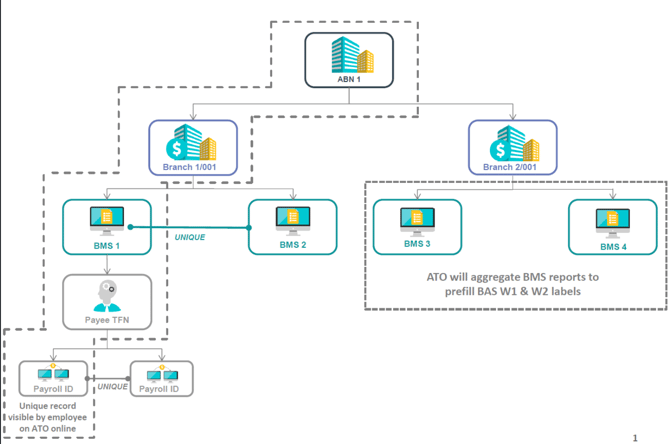STP Business Reporting Structure

This image explains the STP (Single Touch Payroll) Business Reporting Structure, showing how payroll data flows from a business to the Australian Taxation Office (ATO) through different systems and entities. Here’s a breakdown of what each section means:
1. ABN (Australian Business Number)
At the top of the structure is the ABN, which represents the legal entity — the business registered with the ATO.
-
The ABN may have multiple branches underneath it (for example, different offices, regions, or departments).
-
Each branch is identified by a Branch Number (e.g. 1/001 or 2/001).
2. Branches
Each branch represents a separate payroll or business location that reports payroll activity.
-
Branch 1/001 and Branch 2/001 are shown as two distinct entities under the same ABN.
-
Each branch can have one or more Business Management Systems (BMS), which are the payroll systems used to process and report employee payments to the ATO.
3. Business Management Systems (BMS)
A BMS is the payroll software used by a branch to manage and send payroll data via STP.
-
Each BMS (e.g. BMS 1, BMS 2, BMS 3, BMS 4) reports payroll data to the ATO separately.
-
BMSs must have unique identifiers for each employee to prevent duplicate reporting.
4. Payroll ID and TFN Linkage
Each employee is linked through:
-
Payee TFN (Tax File Number): identifies the employee.
-
Payroll ID: a unique record generated by the BMS.
This ensures that the ATO can correctly match pay and tax data to the right employee, even if they appear in different payroll systems.
-
If the Payroll ID or BMS ID changes (for example, when a business changes payroll systems), the link must remain consistent so that employee data isn’t duplicated in ATO records.
5. Data Visibility
-
Employees can view their STP-reported pay and tax information through ATO Online Services (myGov).
-
Each pay record is unique — defined by a combination of ABN + Branch + BMS + Payroll ID.
6. ATO Aggregation
The ATO aggregates (combines) all STP reports from each BMS under the same ABN/Branch to:
-
Prefill BAS (Business Activity Statement) labels W1 (gross wages) and W2 (withholding tax).
-
Maintain accurate year-to-date totals for both the business and each employee.
In summary:
| Component | Purpose |
|---|---|
| ABN | Identifies the legal entity of the business. |
| Branch Number | Separates different business locations or entities under the same ABN. |
| BMS (Business Management System) | The payroll system that reports employee data to the ATO. |
| Payroll ID | A unique code identifying each employee record within a BMS. |
| Payee TFN | Links an employee’s tax record to their payroll information. |
| ATO Aggregation | Combines data from all BMS systems for tax and reporting purposes. |
This structure ensures the ATO receives accurate, consolidated payroll information from all branches and systems under a business, while maintaining employee-level transparency through STP reporting.
